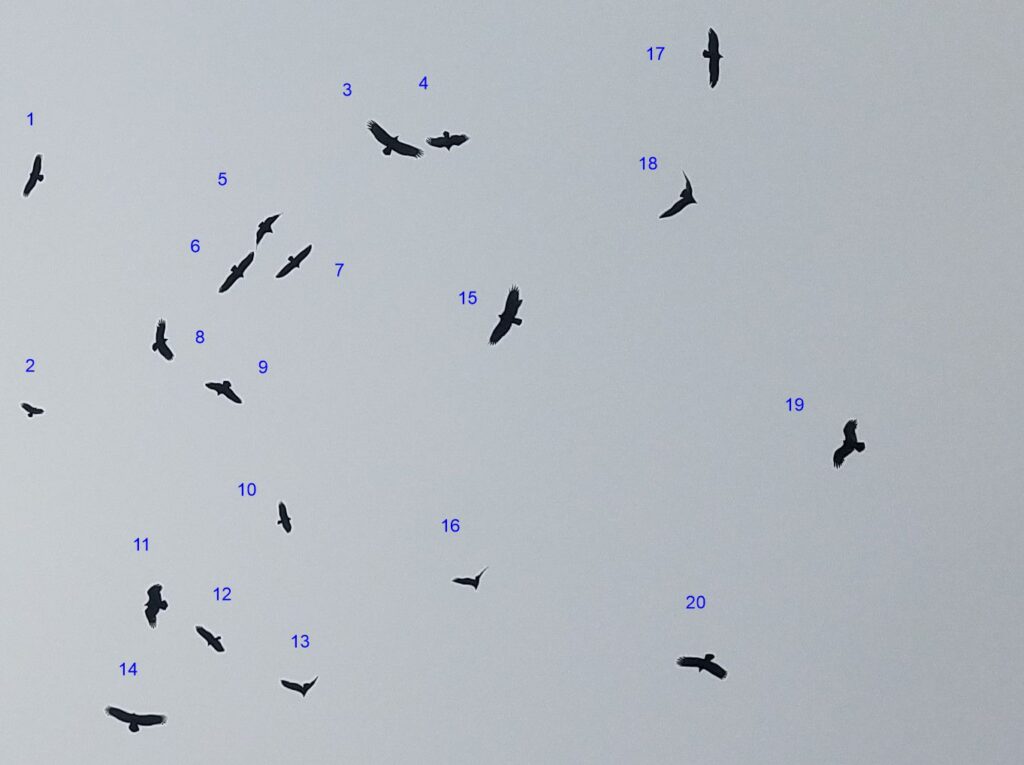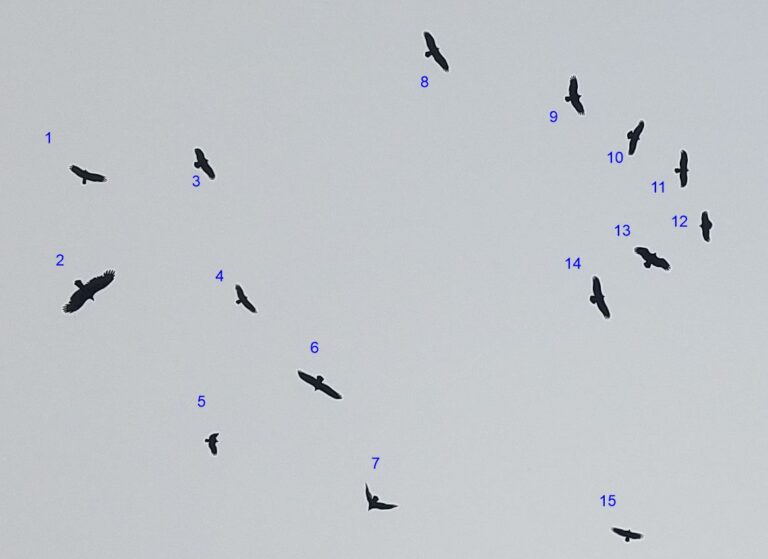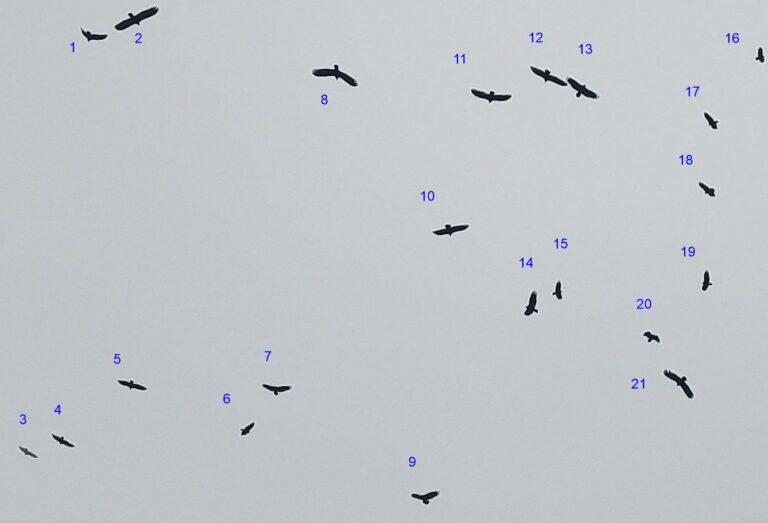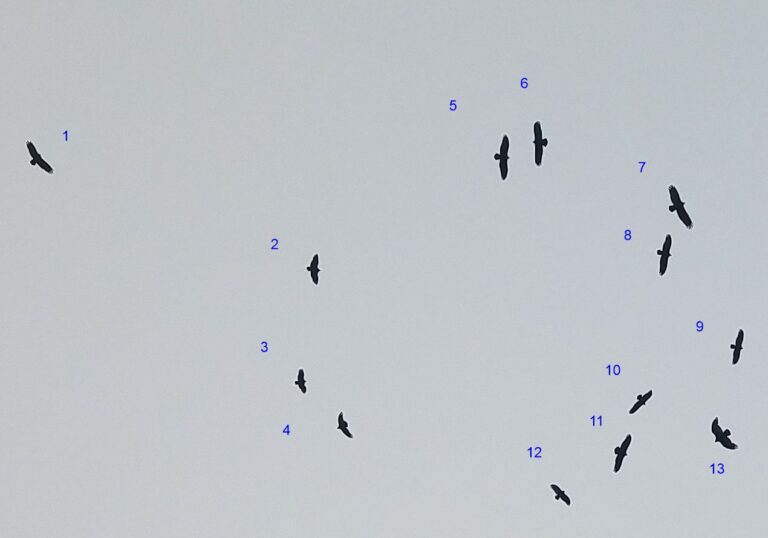Featured Photo: Over 70 Turkey Vultures, frozen in as many different positions, in flight over the South Umpqua River, southwest Roseburg, Oregon, October 7, 2022. These were among many hundreds observed that morning.
Have you ever thought about the challenge of a field guide illustrator? What position will I illustrate this bird in? What pose? What angle? Of course you know the inevitable result for most field guides: typically one position, perhaps two or three. One cannot illustrate infinity in a field guide.
Infinity is the domain of the mind. The mind yearns for infinity; to experience it. At least some minds do. In this post, I will sample infinity. I invite you to observe with me. You may enjoy this. You may be bored and go do something else; that’s okay. I offer this for the interested.
I have simply taken the above photo, and another one like it taken one second later, and cropped out several sections of the broader image, each with 15-20 vultures in flight. I present six images. With each image I have numbered each vulture so as to associate written comments with each. My comments are brief impressions or thoughts; not comprehensive. You may notice things I have not noted, or may have a different interpretation than mine. Feel free to share your thoughts.
In this first image, let’s make some overall observations. What aspects of the shape of these turkey vultures change from one bird to another? Well, size changes, due to distance. Broadness of the wings due to angle and wing position. Overall shape of the wings (straight or angled) due to flight action at the moment, such as flapping, banking, etc. Tightness or openness of the primary “fingers,” again due to flight action. Shape of the tail, whether broad or narrow, due to angle as well as, again, current flight action. Head position or visibility? Because we are basically underneath the birds though at a small angle, I interpret the longer wing to be the inside of its soaring arc. What other differences do you see among these silhouettes? You might take some time to observe the bird shapes and see the differences for yourself before reading my notes, which follow each photo.
IMAGE-A: 1 Full soar, fingers, narrow tail. 2 Closest bird, adult missing inner primaries. 3 Tipped slightly, tail fanned. 4 Tipped slightly, tail less fanned. 5 Farther away, down-stroke flapping, bent wings. 6 Full soar but with closed fingers, straight leading edge. 7 Flapping, between up and downstroke, and turning. 8-11 Full soar at different angles, wings forward on 9, broad tail on 10, narrow on 11. 12 hard bank with very broad tail. 13 Probably down-stroke, angled wings. 14 & 15 Full soar.
IMAGE-B: 1 Broad tail, bulging secondaries, perfect remiges probably hatch-year. 2 Broad tail and mostly full wings. 3-4 Narrower wings, probably slightly angled away. 5 More narrow and pointed wings. 6 Small and farther away. 7 Broad fingers, missing primaries of adult in molt. 8 Headless, wings forward, broad tail. 9 Full soar, broad hand and fingers, perfect remiges of immature. 10 Angled away and left, head hanging down. 11 Angled away so thin wing profile. 12 Mid-down-stroke. 13 Similar path as 10 but below. 14-15 Banking slightly, circling in opposite directions. 16 Primaries swept back, possibly mild flapping or turning into wind.
IMAGE-C: 1 Downstroke or just strong dihedral glide. 2 Very straight wings. 3 Slightly into the fog/clouds. 4 Not quite in clouds. 3-5 have reached the elevation they wanted and are heading south. 6 Distant so more side-angle. 7 Typical soar. 8 Lower end of downstroke. 9 Dihedral or perhaps beginning of downstroke. 10&11 Typical soar. 12&13 Opposite directions. 14-19 Typical soar. 20 Upstroke. 21 Downstroke filling wings and possibly missing primaries.
IMAGE-D: 1 Typical soar. 2 Pointed wings, possibly upstroke turning primary panel. 3 Soar with slight hand adjustment. 4 Strong bank to right. 5&6 Opposite directions. 7-12 Typical soar. 13 Probably upstroke narrowing primary panel.
IMAGE-E: 1 Soar. 2 Beginning downstroke. 3 End of downstroke. 4 End of downstroke. 5 Soar or end of upstroke. 6 Upstroke. 7-9 Soar or light flapping. 10 End of downstroke. 11 Upstroke. 12 Typical soar. 13 may be mid-downstroke. 14 Possibly end of upstroke. 15&16 Typical soar.

IMAGE-F: 1 Typical soar. 2 Soar or beginning of downstroke. 3 Soar. 4 Upstroke or slight correction. 5 Upstroke at angle from rear. 6&7 Typical soar with narrow wings due to angle away from observer. 8 Downstroke. 9 Not sure. 10 Soar. 11 Upstroke. 12 Soar, narrow tail. 13 Beginning of downstroke. 14&15 Soar (with a mostly hidden bird behind 15). 16 Top of upstroke. 17 Soar. 18 Soaring strong left bank and/or possible top of downstroke. 19 Top of upstroke. 20 Mid-downstroke.
Having gone through this once, I would recommend going back to the beginning and see if you notice more things in the shape of each bird than you did the first time through. In any case, I hope your mind’s eye has opened up to a greater appreciation of infinity in the world of bird shapes in flight and in the universe as a whole.
Brought to you by an unlikely peddler of infinity, the Turkey Vulture.







This Post Has 3 Comments
Sorry, you can edit my comment to say there were 6 (not 4) photos with 15-20 vultures each, and only 2 vultures described as having dihedral wing shapes.
Matt, thanks for your detailed comments on Turkey Vultures seen the way we are used to. Guides often describe soaring Turkey Vultures having a distinct dihedral (V) shape, but you’ve shown that in almost all the views of many birds that shape isn’t obvious. Only in photo C, did you use the word “dihedral” twice, among the 15 or so images in each of four photos. I’ll won’t feel bad again for wondering if a distant soaring bird is a TV or a buteo just because I can’t decide if it has a dihedral shape.
You have a great eye for detail, Matt!